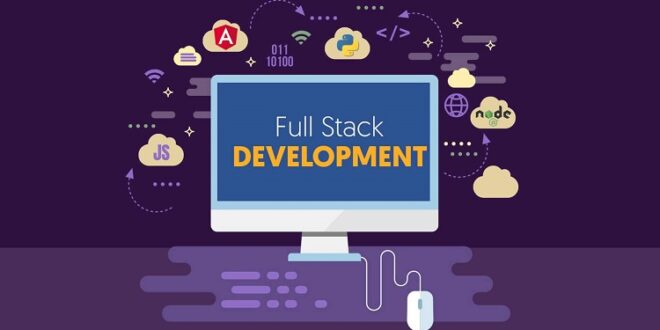As Web Development becomes more complex and sophisticated, the requirements also evolve. Tradition Web Development with old-school designs no longer fulfills the multifaceted needs of dynamic websites and mobile applications. So companies keen on customer experience adopt the full-stack framework to build feature-rich applications. They hire Full Stack Developers who can work on the front end and back end.
To meet the rising demand for Full Stack Developers, prepare for this Subdomain and register for a Full Stack Web Development course. Practice on full-stack projects, earn a certificate, and enhance your resume for Web Development hire.
However, you cannot become a Full Stack Developer overnight. Typically, it takes about 8–10 months to become a Full Stack Developer depending upon your coding proficiency and expertise in necessary frameworks.
Who is a Full Stack Developer
Full Stack Development refers to the development and designing of three layers of development: front end, back end, and database. And a full stack developer can work on the back end, the front end and deploy it to the server, using technologies and frameworks for the same. A Full Stack Developer works on full-stack projects that may be mobile stack, web stack, or native application stack. The work involves handling databases, servers, systems engineering, and clients.
Why learn Full Stack Development
Today Full Stack Software Engineers and Developers are in high demand for their ability to leverage the necessary technology to develop fully functional applications. The expectations from a Developer have evolved to demand much more than HTML, CSS, and JavaScript. Full Stack Developers are expected to know both front-end and back-end technologies. Familiarity with Web Development frameworks like Babel or Boostrap (front end), and Django or Graphene (back end), are in high demand. Full Stack Developers thus need to have well-rounded skills to complete a product independently.
However, you do not need to learn all of these frameworks. You can choose from the front end or the back end to match your core programming skills. For instance, if you are a Java Developer, you may learn React and Node JS rather than Django. And if you are a Python Developer, you can benefit more from learning Django than Angular. Ask yourself what skills you need to acquire for Full Stack App Development.
Top 10 Front End and Back End Frameworks for Full Stack Developers
These are some of the popular Web Development frameworks that a Full Stack Developer must know. Select the related technologies depending upon your background and skillsets.
1. React JS
For the year 2022, React or React JS is the most popular front-end framework. It is an open-source library that allows you to create a front-end application using JavaScript. You can create UIs based on the components for a mobile application or single page.
React is developed and managed by Meta/Facebook.
For JavaScript Developers, React JS can be your choice for Front End Development. However, you must learn the fundamentals of HTML, CSS, Git, and CLI.
Why consider React JS:
- Valuable templates and tools
- Best for dynamic websites.
- Cross-platform support
- Reduces time to code from scratch
- Resource-efficient
- Virtual DOM for high performance
- Used on the server-side with node
- Creates reusable UI component
- Facilitates building and modifying large applications
Used by: Facebook, Netflix, Salesforce, Dropbox.
2. Django
Django is considered the best Python full-stack framework. As an open-source Web Development framework written in Python, Django is in high demand for its inclusion of critical features by default rather than as separate libraries.
Django has MTV (Model-Template-Views) architecture. It is a complete package bundled with various systems and frameworks such as an authentication system, a caching framework, an internal dispatcher system, and more.
For Python Developers, Django may be your choice for front-end development. However, you must learn the fundamentals of Databases like SQLite, MySQL, PostgreSQL, MongoDB, and a text editor like Sublime, Vim, Gedit.
Why consider Django:
- Gives a clean development process and design
- Supports a high-level coding language
- Create complex data-driven websites
- Reusable components
- Fewer code lines
- Uses the Don’t Repeat Yourself (DRY) concept
- Can run with Apache, Nginx, Cherokee, etc
- Supports back ends like Postgres, MySQL, SQLite, and Oracle
Used by: Instagram, Mozilla, Instagram, Spotify.
3. Spring Boot
It is one of the popular back-end frameworks based on Java. Spring Boot is built on top of Spring Framework which runs, sets up, and configures web-based applications. Its auto-configuration and Starter dependencies save time configuring and discovering compatible libraries.
For Java Developers, Spring Boot may be your choice for back-end development. However, you must learn core Java, Servlets, and Spring core basics.
Why consider Spring Boot:
- Easy to set up
- The fast development of standalone applications
- Less time as the amount of source code is reduced
- XML configuration is done away with
- Can directly embed Jetty or Tomcat into spring-based applications
Used by: Trivago, Google, Accenture, Amazon.
4. Angular
Angular is one of the best JavaScript GUI frontend frameworks with standardized modules and code. Written in TypeScript, this open-source framework maintained by Google allows you to write testable code.
If you are a JavaScript Developer and do not want to use React, then Angular is your best choice for full-stack development. Begin by learning the MEAN stack, MongoDB, and Express.js.
Why consider Angular:
- Supports building high-quality applications
- Wide community and ecosystem for support
- Higher speed and performance
- Support for lazy loading and Ionic.
Used by: Google, Paypal, Microsoft, Upwork.
5. GraphQL
GraphQL is a JavaScript library for APIs, providing a runtime for queries with existing data in your API. It consists of a query language, static validation, type introspection, and execution semantics, making it easier to evolve APIs over time with powerful developer tools.
GraphQL provides an approach to creating Web APIs and allows clients to define the required data structure.
Before starting with GraphQL, learn the fundamentals of Syntax, Relay, Apollo, and Resolve.
Why consider GraphQL:
- Fetches data with a single API
- Auto generates API documentation
- No over and under fetching
- Supports complex systems and microservices
Used by: Facebook, Instagram, Twitter, StackShare.
6. Node JS and Express.js
Another popular JavaScript Web Development framework is Node JS, for back-end tasks, web applications, and server-side code. The combination of Node JS and Express.js in an open-source framework supports the creation of fully functional web apps.
For JavaScript Developers, learning JavaScript, NodeJS, and Express.js along with React or Angular help prepare for Full Stack Development.
Why consider Node JS and Express.js:
- Improves response time and performance.
- Cost-effective and active community support.
- High-performance and easy scalability.
- Helps in building cross-functional teams.
- Support caching
Used by: Yahoo, Uber, eBay, Twitter.
7. Bootstrap
Bootstrap has replaced CSS as the best framework for front-end Web Development. It is an open-source framework with CSS and JavaScript-based design templates, useful in the full-stack development learning curve.
Beginners or JavaScript Developers must get familiar with JavaScript, HTML, and CSS. It is an ideal framework for developing mobile-first applications.
Why consider Bootstrap:
- Used for mobile-first apps
- Can be customized
- Responsive structure and style
- Vibrant community support and documentation
- Less cross-browser bugs
Used by: Spotify, Twitter, Udemy, LinkedIn.
8. Flask
This is a must-learn Python framework for Web Development in 2022. Flask is a back-end micro-framework that runs independently without libraries and tools. It supports extensions for add-on application features.
Why consider Flask:
- Scalability for simple apps
- Easy routing of URLs
- Supports technical experimentation
- Capable of higher compatibility
- Easy for building a quick prototype
Used by: Netflix, Reddit, Mozilla, Uber.
9. Ruby on Rails
It is another full-stack framework for Web Development, making it easy to build database-backed web apps. Ruby on Rails follows the MVC (Model-View-Controller) framework for building web pages, servers, and database structures.
To become a Full Stack Developer using Ruby on Rails, you must first learn CSS, HTML, SQL, and JavaScript.
Why consider Ruby on Rails:
- Conventions over configurations (CoC) paradigm
- Uses the DRY concept
- Safe and secure
- Facilitates rapid development
- Ease of maintenance.
- Trouble-free code maintenance and updates
- Automated testing
Used by: Airbnb, Shopify, GitHub, Bloomberg.
10. jQuery
This is another powerful open-source JavaScript library for Web Development in 2022. It provides CSS-like selectors to change elements on the fly and simplify HTML DOM tree traversal and manipulation.
Why consider jQuery:
- Code is simple, readable, and reusable
- An extensive library
- Supports Ajax
- Plenty of plugins
- Speeds things up with fewer lines of code
- Makes it easier to use JavaScript on the website
Used by: Dell, Amazon, Google, Uber.
Summary
Merely knowing HTML and JavaScript is not enough. Learning popular frameworks can help you become an independent Full Stack Developer.
Your learning path must include at least one open-end framework and one back-end framework that matches your programming skills.
 HammBurg Be informed with latest news, reviews, entertainment, lifestyle tips, and much more.
HammBurg Be informed with latest news, reviews, entertainment, lifestyle tips, and much more.




